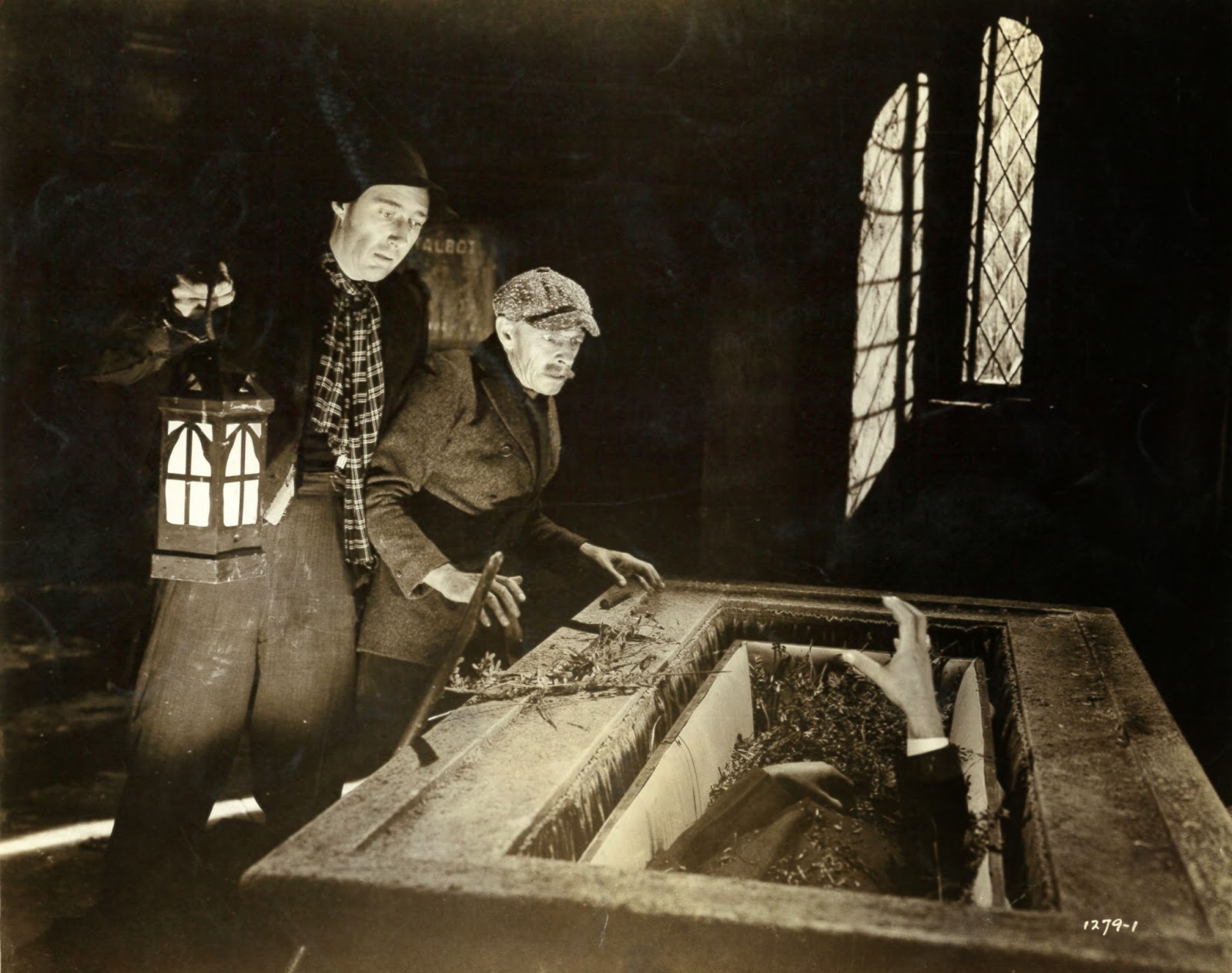Let Scares Be Multiplied
 |
| This Opener Scene Got Frankenstein Meets The Wolf Man Off To A Roaring Start |
Monster Mashing When Frankenstein Meets The Wolf Man (1943)
The perhaps scariest scene in all of Universal horror comes at the beginning of this, but just as creepy stuff was done routinely in Sherlock Holmes mysteries also at U and directed by Roy William Neill, who hung up his deerstalker for a one-time dance with Uni monsters (single previous horror film, The Black Room, also excellent). Again I say, if the man had not died early (1946), he'd be cultish and a major noir name for ones in that category he'd have surely done if not for fate's intervention. Universal missed a bet by not putting Neill in directorial charge of all their thrillers; he could have, for instance, elevated the Inner Sanctums with Chaney sure as he had the Holmes with Rathbone. What with Neill and Robert Siodmak on the lot and active, U could have spilt chillers between the pair and made Blackjack every time.
F Meets W was one the Shock (Theatre) watchers dreamed to see. Imagine these two locked in (im)mortal combat! And the fight in this case lived up to promise, stuntmen turned loose in reprise of melee staged a year before on The Spoilers, Frank/Wolf being but applianced vary on John Wayne, Randolph Scott, and same doubles knocking brains out in the Yukon. I knew at age 11 that F Meets W would be a pip and, if not a best in the series, certainly the liveliest. F's monster is on ice instead of sulfur this time; like deer meat, you had to keep him fresh between rounds. Universal was around to doing each monster on per year basis, so then-youth got Mummies, lycanthropes, eventual Ape girls, often as Santa Claus. The films were in unapologetic rut after the first Wolf Man, but weren't sloughed as were series elsewhere that ran down meters quicker.
Chaney dominates in a role he felt proprietary toward. There had been weight gain since The Wolf Man two years before, but he still wore suits well, initial contact with Illona Massey (as Frankenstein's daughter) giving us glimpse of romancer Lon in twilight. "Poor" Bela Lugosi finally plays the Monster he turned down twelve seasons back, by 1943 aware that was defining career misjudge. F Meets W came between Monogram assignments for Lugosi. Critics ignored these and actors thought Mono a slumming address, if not outright disease, but showmen appreciated the little company for always delivering on product promise (most poverty rowers failed at that). Urban "shooting galleries" plus small towns relied on Monogram for fill of bills aimed at Saturday and exploitation markets, these needed more now that we were in a wartime boom. Lugosi in 40's decline? On the contrary, this period between declaration and surrender was a peak of his movie exposure, if not success.
 |
| Original Caption Indicates This Was Chaney's Own Pet, "Moose," ID'ed By Universal as "Famed Dog Actor." |
Shuffling the monster deck was inevitable, characters largely played out for individual sequels. Besides, the war had acted as sugar high for kids who wanted movies louder and more boisterous. How else do you explain Abbott and Costello, also out of Universal? The monsters didn't necessarily lose respect, as most understood thrones they once sat on, plus there'd been revival of originals Dracula and Frankenstein to remind everyone that these were cherished franchise. Universal in observance lent real polish to Frankenstein Meets The Wolf Man (negative cost: $238,071). Their mini mock-up of the castle and looming waterfall is a landscape on which model railroaders might thrive. Family feeling is maintained by vets of the series now a stock company as sequels piled up: Lionel Atwill, Dwight Frye, numerous others known better by faces than names.
A joy for youth at the time and since is action getting immediately underway with no time spent on exposition or origin stuff re the monsters. We knew their predilections by 1943 and were eager to get on with it. Monster rallies were ideally keyed to wartime patience levels. The Wolf Man comes a-killing to a first reel and does so twice before brief subdue by ineffective authority. By way of loud, there is a mid-way "Festival Of The New Wine" that bids for outsize production number status with oodles of extras, a highlight to reassure us that U wouldn't take admission money for nothing. Lab stuff as practiced before repeats in observance of tradition, except now we're confused (at least I was) by whose energy was supposed to be channeled into what. A climactic blow-up and flood leaves plenty of real estate in which the monsters can hibernate and be found when next needed. Frankenstein Meets The Wolf Man streams current on VuDu and looks great in HD. It along with other 40's sequels needs to come out on Blu-Ray, so write your congressman.















































